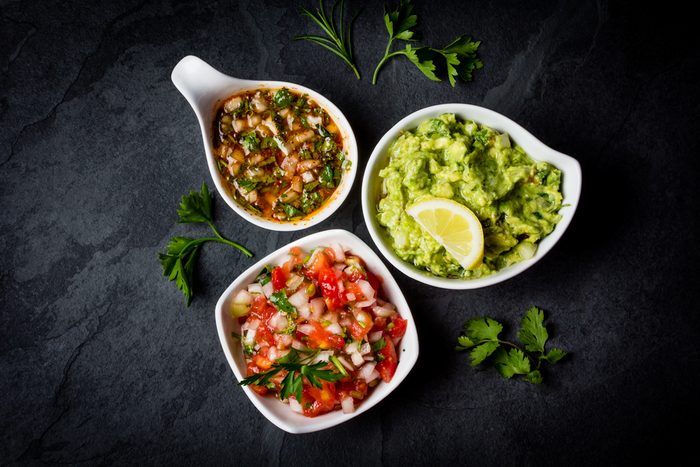
1. Salsa
Are dips and sauces hijacking your healthy eating habits? Calories and fat can lurk in the tasty dressings that you love. But you can garnish your foods with colourful, mouthwatering sauces – and boost your health. Here are eight dips and sauces that add flavour and nutrients – not calories – to your diet.
Peppery and oh, so good for you, salsa is a colourful way to tantalize your taste buds. Different salsas are available at your supermarket, but Sarah Remmer, a Calgary-based registered dietitian and nutritionist, says that you can boost salsa’s healthy reputation by creating your own using chopped raw tomatoes, onions, lime juice, garlic and jalapeño peppers. “Salsa is a great low calorie, nutrient-rich sauce,” she says. “Tomatoes contain large amounts of folate, vitamins A and C as well as lycopene, a cancer-fighting antioxidant. Onions and garlic are high in flavonoids and allyl sulphides that may help reduce the risk of certain cancers and heart disease.”
Remmer suggests using salsa as a dressing for taco salad, a topping for omelets, grilled chicken or turkey. “It’s also a delicious, healthy dip for crackers and tortilla chips,” she says.
2. Pesto
The most popular pesto contains basil, olive oil and pine nuts, but there are other varieties that include cilantro, parsley, walnuts or almonds. According to Remmer, your body will benefit from the monounsaturated fats in the olive oil, and the polyunsaturated fats in the pine nuts, walnuts and almonds. These healthy fats can help boost heart health and lower cholesterol. “Fresh basil has anti-microbial, anti-bacterial and anti-inflammatory properties, and is high in vitamin K, a vitamin that is important for blood clotting,” she says. If you’re making homemade pesto, be sure to choose nuts that aren’t cooked in sugar or pre-salted.
Pesto can liven up many foods. Use it as a pizza sauce, veggie dip or on grilled salmon.
3. Chutney
Sweet and zesty, this South Asian condiment provides a yummy accompaniment to your sandwiches, hors d’oeuvres or appetizers. Most chutney recipes call for fruit, vegetables, spices and vinegar. Popular varieties include mango, onion, and mint. Remmer says that adding chutney to your plate is a great way to amp up nutrition. “Low in fat, full of fruits and/or veggies, this sauce is a winner,” she says. “Depending on the chutney, it may contain added sugar and salt, but it still makes for a healthier dip compared to others.”
Skip applesauce and try chutney with pork chops. Turkey gets a tasty makeover when chutney is substituted for cranberry sauce.
4. Wasabi
A popular condiment in Japanese cuisine, wasabi offers a strong, spicy flavour. Created from a root vegetable, wasabi contains isothiocyanates – compounds that are notable for their cancer fighting activities.
Give your tossed salad a kick by mixing in a little wasabi, or use it as a distinctive dip for chips. Roast beef sandwiches go from bland to spectacular when a layer of wasabi is spread between the bread.
5. Guacamole
Forget the so-called health experts that complain about the fat content in avocados. Remmer says that the vegetable actually contains healthy monounsaturated fats as well as fibre, potassium, folate (great for women of childbearing age), vitamin E and lutein (beneficial for eyes). They also feature oleic acid that helps knock back bad cholesterol and has been linked to decreasing risks for diabetes and cancer. Just watch serving sizes. “Avocados, as healthy as they are, are high in calories,” says Remmer.
Top burgers, turkey sandwiches and pizzas with guacamole, and add it to your baked potatoes and quesadillas.
6. Worcestershire sauce
A stable in the British Isles, Worcestershire sauce is low in calories, but high in flavour, iron, B vitamins and vitamin C. The vitamin B6 found in the sauce’s garlic, cloves and chili pepper extract can kick start the immune system, while the onion’s antioxidant quercetin is believed to have anti-inflammatory properties. Some types of Worcestershire sauce can be high in salt, so opt for a variety that has less sodium, or limit your consumption to a few tablespoons per meal.
Steak and Worcestershire sauce is a match made in food heaven. Also, hamburgers become more flavourful with this sauce added to their mix.
7. Tabasco
Spice up your plate with Tabasco sauce and feel healthier. Tabasco is made from chili peppers, “a major source of the chemical capsaicin, the component that gives this sauce its heat,” says Remmer. “Capsaicin may aid with digestion and could help fight infection. Plus, the red chill peppers in Tabasco may also help to decrease your appetite and increase calorie expenditure, both which may help with weight loss,” she says.
Sprinkle Tabasco into your spaghetti sauce, stir-fries and on cooked beef.
8. Ketchup
The main ingredient of ketchup – cooked tomatoes – is the winner in the lycopene stakes. Cooked tomatoes boast more of this antioxidant than any other food. Remmer says that lycopene can lower your risks of cardiovascular disease, prostate, lung and stomach cancer. To reap the benefits of ketchup on your plate, find a variety with limited sugar.
